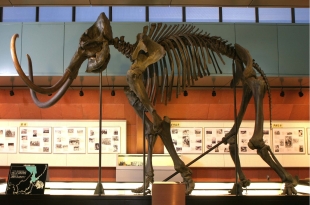1-1 Mammoth
The woolly mammoth (Mammuthus primigenius) migrated from Eurasia to Hokkaido around 30,000 years ago, during an especially cold period of the last ice age. Sea levels fell, and glaciers advanced to create a bridge connecting the island of Sakhalin, north of Hokkaido, to the Eurasian continent. Several animal species migrated from Eurasia to Hokkaido during that period. Some, like the Siberian salamander, still inhabit the Kushiro area today.
The woolly mammoth was around the same size as an African elephant. It was well adapted to the cold; its body was covered in a layer of long, coarse hairs with a shorter furry underlayer. Fossilized mammoth teeth were discovered in several locations near Kushiro, including Cape Erimo to the south. This skeleton is a replica, modeled on fossilized mammoth bones discovered in Siberia. It is 3.5 meters long and 2.9 meters high, with 2.5-meter-long tusks.

This English-language text was created by the Japan Tourism Agency.
このページに関するお問い合わせ
生涯学習部 博物館 博物館担当
〒085-0822 北海道釧路市春湖台1番7号 博物館
電話:0154-41-5809 ファクス:0154-42-6000
お問い合わせは専用フォームをご利用ください。
